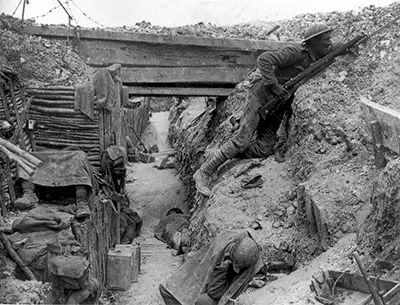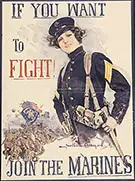Trench Warfare
Trench warfare describes fighting that occurs in deep trenches. These are dug into land both to protect the soldiers and also making it difficult for the opposing army to attack. Fighting in these trenches usually protects soldiers with from bullets and most artillery shells.
In between the trenches of the enemies is an area known as “no-man’s land”. This area is not protected from the weapons of either side, and is dangerous to walk through. It is difficult to force the enemy to retreat, because it is too dangerous to move forward over no-man’s land towards the enemy.
World War 1 was famous for trench warfare along the Western Front, with the first trenches dug on 15 September 1914. Trenches were not as popular on the Eastern Front, with the battle lines moving often, meaning there was no time or need to dig them. The battle lines moved quickly because the length of the Eastern Front was so great that there were fewer soldiers along it. As a result, it was easier for the enemy to break through the battle line, and both armies had to adjust to the new fighting frontier.


The use of more modern weapons during the war, and complicated systems of fighting, meant that trench warfare was considered an ideal way of protecting soldiers. This meant that, for example:
- The French were unable to attack with their favorite method of using speed to surprise the enemy. This was because they could not rush towards the Central Powers due to the danger of being killed in no-man’s land
- Germany’s new weapons, such as machine guns, were not as effective. This was because the Allied Powers were able to hide from the straight line of bullets behind the trench wall
Trench warfare was using during the war along the Western Front until 21 March 1918, when the Germans started their Spring Offensive. Germany used small groups of soldiers to move through areas with weak defenses. The initial attack by the Germans included the use of poisonous gas in the trenches and artillery to destroy supply lines and artillery. The Allied Powers retreated from their trenches and the battle line moved too much for trench warfare to continue.
The first trenches used were quite simple and in straight lines, with soldiers fighting alongside each other. But this led to more dead or injured if an artillery shell landed nearby or an enemy solider was able to get into the trench and fire down the line. This was because there was no protection for the troops. As a result, trenches were dug at angles or with curves in them (such as around mounds of earth). This meant that pieces of shell or bullets could not pass through obstacles such as earth and sandbags.

Along the Western Front, the no-man’s land was normally around 100-300m wide. In Gallipoli, there were some areas where there was only 15m between enemy trenches. This meant that soldiers could throw grenades into each other’s trenches.
From time to time, armies organized official truces so the wounded and dead could be recovered from no-man’s land. Even where commanders did not support truces, soldiers would often refuse to attack enemy stretcher-bearers who were retrieving the wounded.
As the war progressed, trenches became deeper (to around 4m) and grew larger. Trenches varied in direction, leading away from the front line back to supply lines. This allowed communication and travel between different areas of the front line. Reserve trenches were also dug behind the front trenches. This meant that if the front trenches were captured, there were troops in the rear trenches who could continue fighting and stop the enemy’s advance. Trenches called “saps” were trenches dug out into no-man’s land. They were used as listening posts if they were close to the enemy’s communications lines, or could be used for surprise attacks.

Germany was able to develop an advanced system of trenches, having studied past wars as a guide. They used concrete to strengthen their trenches and make them better able to withstand artillery fire. They also built their trenches with special forts that allowed more than single rows of soldiers to fire at any given time.
Trenches generally had sandbags, wooden frames and floorboards inside them, with a step the soldiers used to fire from. Troops would use a gap in sandbags sometimes reinforced with a steel plate, to shoot through without being exposed to the enemy. Some German trenches even used concrete stairs, which allowed soldiers to move between different trench levels. The most common weapons used by soldiers were rifles, bayonets and hand grenades.

There were three main methods of actually digging trenches:
- Entrenching – standing on the surface and digging downwards. This was the fastest way to dig trenches, but left troops exposed above ground to attack
- Sapping – digging away at the face of the existing trench, which took longer but protected the troops from attack
- Tunneling – digging away at the face of the existing trench but leaving soil at the top of the trench while a tunnel was being dug. The “roof” of the trench was only removed when it was about to be occupied

Soldiers usually spent one day to two weeks in the trenches before being replaced by fresh soldiers. This allowed them to rest and rotate through support duties such as filling sandbags or acting as reserve forces. But some Portugese soldiers in France had to fight for as long as six month in the trenches due to lack of reinforcements and a high casualty rate.
There was limited medical support in the trenches, meaning that even simple injuries could result in death due to infection. Many infections set in when a shell fragment carried dirt into a wound. As a result, artillery shell injuries were often more dangerous than gunshot injuries. Soldiers could also die or suffer long-term damage from head injuries caused by exploding shells.
With poor sanitary conditions, infections such as dysentery and cholera, parasites, fungal problems and extreme cold weather during winter also affected the health of the soldiers fighting in trenches.
The trenches were dirty and could be filled with water and become muddy, and were often infested with rats and lice. They constantly required repair, especially due to damage from bombs and the weather conditions.
Trench warfare was not a pleasant method of fighting, but became one of the most well-recognized means of fighting in World War 1.



